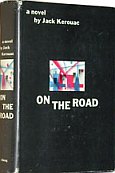In the introduction of Robert Frank’s landmark photography collection The Americans, Jack Kerouac described Frank’s plaintive black and white images as: “That crazy feeling in America, when the sun is hot on the streets and the music comes out of the jukebox or from a nearby funeral.” It was originally published by Robert Delpire in Paris in 1958 as Les Américains, and it featured 83 of Frank’s photographs taken in America during 1955 and 1956, accompanied by writings in French about American political and social history that were selected by Alain Bosquet. Today it is considered to be the most famous photography book ever published, as it changed the face of the medium forever.
For Jack Kerouac who was at the mid-point of his career at the time, it was yet another cultural phenomena with elements of the Beat Generation that included rejection of the status-quo and materialism, innovations in style, an interest in Eastern religion, and explicit portrayals of the human condition with experimentation with drugs and alternative sexualities. Together with Allen Ginsberg, author of Howl (1956), and William S. Burroughs, author of Naked Lunch (1959), Jack Kerouac helped liberalize publishing in the United States by celebrating spontaneity and non-conformity.
Kerouac wrote his first novel The Town and the City in 1950, but the highlight of his career came in 1957 with the classic of the Beat Movement On the Road, a depiction of the rejection of mainstream American values as portrayed by a physical and metaphysical journey across America. It led his critics to the conclusion that he was an un-American, anti-intellectual and drug crazed, marginally liberal author. Kerouac‘s novels however, demonstrated a staying power well after his death in 1969, and his road remains well travelled.
Collectors of Kerouac’s works are running out of affordable material to invest in. His best known and most influential work remains On the Road, with signed copies demanding over $10,000. In 2001, the original scroll of On the Road, was bought by James Irsay, owner of the Indianapolis Colts, for $2.43 million. A more affordable alternative, with non-signed copies, is offered by the continuation of the journey, with emphasis on the quest for illumination through Zen Buddhism and his 1958 fourth novel The Dharma Bums. Beyond these two journey books, famous other works include Doctor Sax, Mexico City Blues, The Subterraneans, Vanity of Duluoz, Desolation Angels, Visions of Cody, The Sea is My Brother, Big Sur and The Town and the City.
When Jack Kerouac died in 1969, he died broke in line with his Beat Movement beliefs. His literary collection and belongings are today as valuable as they have never been before, with Kerouac’s beneficiaries still trying to sort things out. Furthermore, On the Road alone sells more than 60,000 copies a year. Even Frank’s The Americans has been reprinted by different publishers in multiple languages and formats, including the 50th anniversary edition with additional content. Kerouac once ranked Robert Frank, who is still with us by the way, not among other photographers, but ‘among the tragic poets of the world.’ He sensed a tragedy with a poetic tone through the pictures of the American people of the mid 50’s. These are the same people and their descendants that he inspired and continues to inspire through his writings. Indeed, Ray Manzarek, keyboard player of The Doors, wrote in his book Light My Fire: My Life with The Doors : “I suppose if Jack Kerouac had never written On the Road, The Doors would never have existed.”

{ 0 comments… add one now }
{ 3 trackbacks }